[ENG/ESP] Young Frankenstein a horror classic transformed into a comedy classic / El Joven Frankenstein un clásico del horror transformado en clásico de la comedia |REVIEW - RESEÑA|
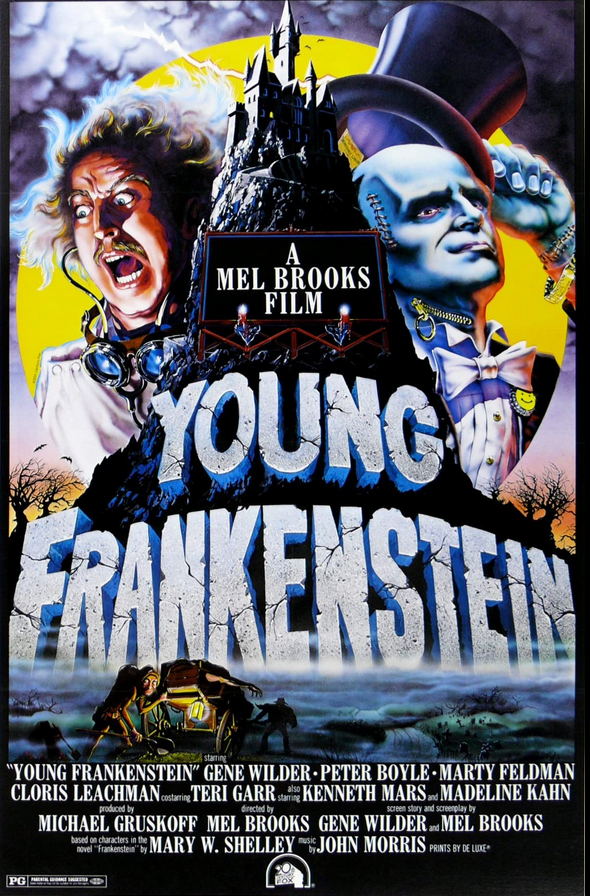
Making a comedy out of a horror classic like Frankenstein is not easy.
Mary Shelley's book (under this pseudonym was hidden the writer Mary Godwin, creator of the world famous "monster"), was taken to the big screen countless times with different luck and with actors who tried to mimic the character.
However, when it comes to making a comedy, no plot is impossible for Mel Brooks, who achieves his goal by obtaining a product of the highest acting quality, where horror serves only as a thread of the story for those unsuspecting who do not yet know the story.
The performances of Gene Wilder, Marty Feldman and Peter Boyle are decidedly astounding, shocking, a humor where many times the gags replace the words. Shooting the film in black and white was a challenge for Mel Brooks, who managed to transform horror into comedy, giving it a somber and suspenseful tone. Especially because with color some details go unnoticed to our mind, where the overall visual effect has a certain preponderance over the rest.
In Young Frankenstein this is not the case. All the details of the film are in plain sight because they are the ones that generally make us laugh out loud. As, for example, when the hunchback Aigor (memorable interpretation of Marty Feldman) makes the horses of the carriage neigh when he turns to them and opening his huge eyes to the maximum, pronounces the name of the ruler of the castle, the enigmatic Frau Blucher.
Or when digging up the corpse from the cemetery, Professor Frankestin says to his assistant Igor: "What a lousy job!", to which Igor replies: "It could be worse", "For example?", says the professor. "Raining" replies the assistant and suddenly a rainstorm breaks out.

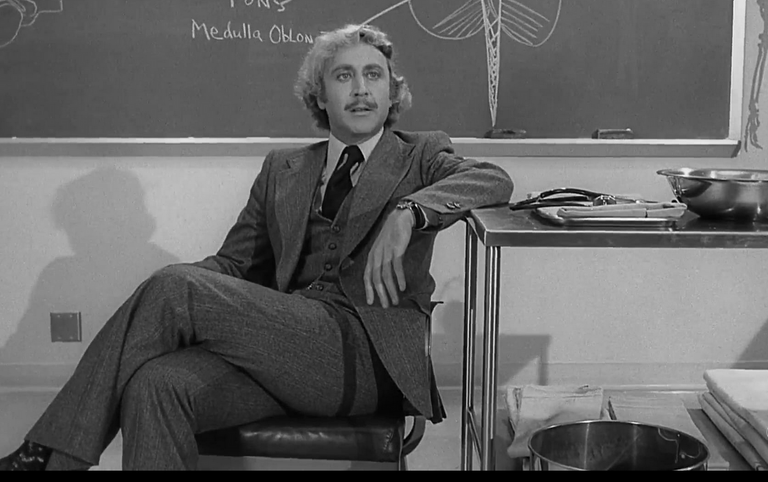
Hacer una comedia con un clásico del horror como Frankenstein no es fácil.
El libro de Mary Shelley (bajo este pseudónimo se escondía la escritora Mary Godwin creadora del "monstruo" de fama mundial), fue llevado innumerables veces a la pantalla grande con distinta suerte y con actores que trataron de mimetizarse con el personaje.
Sin embargo, cuando se trata de hacer una comedia, ningún argumento es imposible para Mel Brooks, quien logra su cometido obteniendo un producto de altísima calidad interpretativa, donde el horror sirve solo como hilo conductor de la historia para aquellos desprevenidos que aún no conocen la historia.
Las interpretaciones de Gene Wilder, Marty Feldman y Peter Boyle son decididamente para el asombro, estrepitosas, un humor donde muchas veces los gags substituyen a las palabras. Filmar la película en blanco y negro fue todo un desafío para Mel Brooks, que logro transformar el horror en comedia, dándole un tono sombrío y de suspenso. Sobre todo porque con el color algunos detalles pasan desapercibidos a nuestra mente, donde el efecto visual general tiene una cierta preponderancia sobre el resto.
En el Joven Frankenstein no es así. Todos los detalles del film están a la vista porque son los que, generalmente, nos hacen reír a carcajadas. Como, por ejemplo, cuando el jorobado Aigor (interpretación memorable de Marty Feldman) hace relinchar a los caballos de la carroza cuando se gira hacia ellos y abriendo al máximo sus enormes ojos, pronuncia el nombre de la gobernanta de del castillo, la enigmática Frau Blucher.
O cuando desenterrando el cadáver del cementerio, el profesor Frankestin le dice a su ayudante Igor: "Que trabajo asqueroso!", a lo cual Igor responde: "Podría ser peor", "por ejemplo?", dice el profesor. "Llover" responde el ayudante y de repente se desata un temporal.

The plot begins in a university class of the neurologist professor Frankestin (who has decided to change his last name slightly to differentiate himself from his grandfather, the celebrated scientist Victor von Frankenstein, author of several medical theories considered by his grandson as absurd and the product of an unbalanced mind).
The first smile on the viewer's face comes when the professor reacts angrily to the question of one of his students who, first, calls him by his grandfather's surname to provoke him and then asks him if it is possible to revive a dead person by transplanting properly preserved organs from another deceased person. In his violent reaction, the professor (a brilliant Gene Wilder) repeatedly hits the desk with his fist without realizing that inside the desk he is clutching an iron punch used in his practical explanations. On the third blow he misses the desk and drives the punch into his leg. With a limp and a grimace, he leaves the classroom to the hilarity of his students.
On leaving the university he is visited by a lawyer who, on behalf of his grandfather, informs him that his grandfather has died and has left him a castle in Transylvania, Romania.
Although, at first, he is inclined to reject the inheritance because of the deep contempt he feels for his grandfather's experiments, curiosity is stronger and he decides to travel to Transylvania to see what it is all about.
When he arrives at the castle he is greeted by the servant Aigor (hunchback, but with the particularity that he can change the position of the hump at his pleasure) who actually introduces himself as Igor welcoming him by calling him Professor Frankenstein. Once again feeling a surname he detests, the professor tells him that his surname is not that, but Frankestin (and emphasizes the syllables so that he understands). The servant does not take the answer very well and replies that, in the future, he will also be called not Igor but Aygor. All this sequence of gags and comedy so much in the style of Mel Brooks will be repeated throughout the film.
Igor (or Aygor) takes the suitcases of the newcomer and to spite him he turns to the horses in the carriage and dryly pronounces the name: Blucher, which is the surname of the ruler of the mansion, knowing that the animals react frightened and in this case neighing when they feel it. Satisfied and smiling, he enters the castle with Professor Frankestin.
Once installed, the professor devotes himself to review the old manuscripts of his grandfather referring to his experiments to revive dead people with other people's organs and applications of electroshocks and realizes that they are so crazy. In short, his grandfather was not so crazy, on the contrary, he was a scientist with a vision of the future. And as he goes on reading all the material the old baron had left behind, the more he becomes convinced that the project can be realized.
Thus, with the help of Igor, the assistant Inga and Frau Blucher they go to a cemetery at night and steal a barely buried corpse. To bring it to life, they need to steal a brain, and Igor must take on this task and sneak into a laboratory where there are several brains in formaldehyde for experimentation.
When he picks up the right brain (according to the professor's instructions) he turns to walk away, but stumbles and falls, breaking the jar and rendering its precious contents useless. In desperation he picks up from the shelves the first jar he finds within reach without realizing that on the label identifying each brain is written "abnormal", i.e., it is the brain of a mentally disturbed person.
The viewer already begins to imagine the hilarious series of gags and laughs that follow.
On the roof of the castle, the professor places the corpse with the transplanted brain (ignoring Igor's accident) and places a series of electrodes around the head that he connects to a lightning rod (following the scheme of Benjamin Franklin's invention) on a stormy night.
The electrical impulse of the lightning manages to give life to the creature and he experiences, an event is revealed. But while everyone is celebrating amidst the merriment, the monster wakes up and tries to strangle the professor. A sedative given with an injection calms it down, but the professor does not understand the reason for the reaction and therefore begins to coax the truth out of Igor. When Igor tells him the whole story, he tries to strangle the assistant in a gesture of rage, but the assistants manage to separate them.
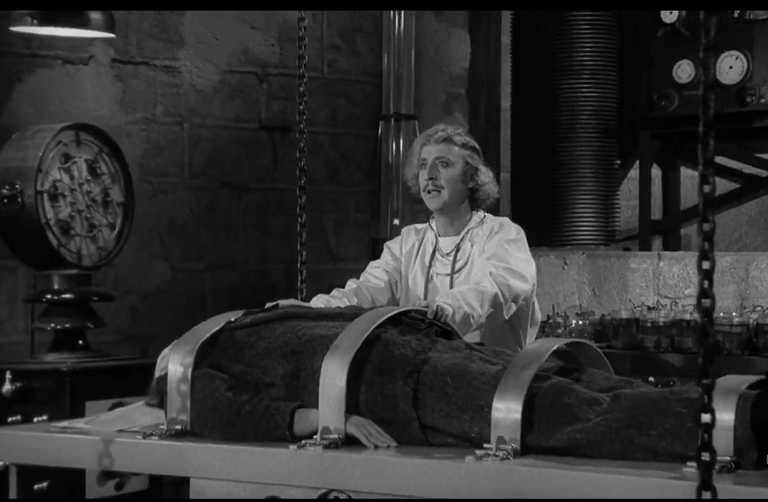
When the monster slowly wakes up, Professor Frankestin begins to explain the situation, telling him that he is also a special human being, with all the virtues and defects that others have. She is sympathetic and manages to convince him to attend a scientific meeting in a theater where distinguished colleagues of the profession, generally very skeptical, have been invited.
Everything is going along normally, in a more than pleasant evening, until the beginning of a fire in the theater frightens the monster who flees. On his escape route he comes across a little girl who has wandered away from home without telling her parents and is playing in the garden at night in a hammock. He tries to give her a push to help her swing, but it is so strong that the girl flies off and lands on her own bed to the delight of her parents who have just opened the bedroom door.
She continues on her way and meets a blind beggar (whom the monster actually takes for deaf) with whom she first shares a bowl of soup (while trying to ladle it into the bowl, she pours it down the poor blind man's pants -a brief but hilarious appearance by Gene Hackney, Then he shares a cup of coffee and when he tries to toast them both, he hits both cups with such force that he breaks them, and finally he offers him a cigar and instead of lighting the cigar he lights the poor beggar's gloved finger on fire.
All the scenes are hilarious, hilarious, of such genuine and gestural comedy that one never tires of watching them (I saw the film three times).
At the end he is captured by the police, locked up and subjected to psychological torture by one of the guards, who scares him with fire. At a certain point, very frightened, he hits the policeman and runs away from the prison again.
At this point he knows that the only safe place is the castle because he knows that Professor Frankestin will protect him.
In fact, when he arrives and is welcomed by the whole group and after a brief discussion, Professor Frankestin generously decides that the only way to save him is to donate his brain, so that he will learn to speak and no one will be able to accuse him of being a monster, he will be just another human being.
At this point, Igor himself and Inga, his girlfriend who had accompanied him from the USA, try to dissuade him, but the professor maintains that if they want to save him, this is the only possible alternative.
They prepare the experiment again and at the climax of the experiment the police interrupt in the castle. They both rise from the stretchers and Police Inspector Kemp discovers that they are both human, even though one has a scar that encircles his entire head.
The biggest question mark is whether all went well in the experiment: indeed, the last sequence shows a robe-clad monster in the company of assistant Inga as she reads a financial news journal.
But the monster that transferred him to the professor?
We go back a bit. In his first escape, the monster to take revenge had gone to the professor's house and raped his girlfriend (although the word raped is perhaps excessive because apparently Elizabeth - the professor's girlfriend - had been very satisfied with the proof of the dimensions of the monster's reproductive apparatus). And she expresses her joy and pleasure by singing a soprano air.
Well, in the final scene the professor turns off the light implying that they intend to make love to each other and after a few moments the same air, satisfied, of pleasure, of soprano, is felt.
The spectator in the midst of hilarity discovers what the monster has transferred to the professor. Even in the midst of a concept of a certain vulgarity, Mel Brooks succeeds in pulling from the spectator a broad smile that has nothing vulgar about it.
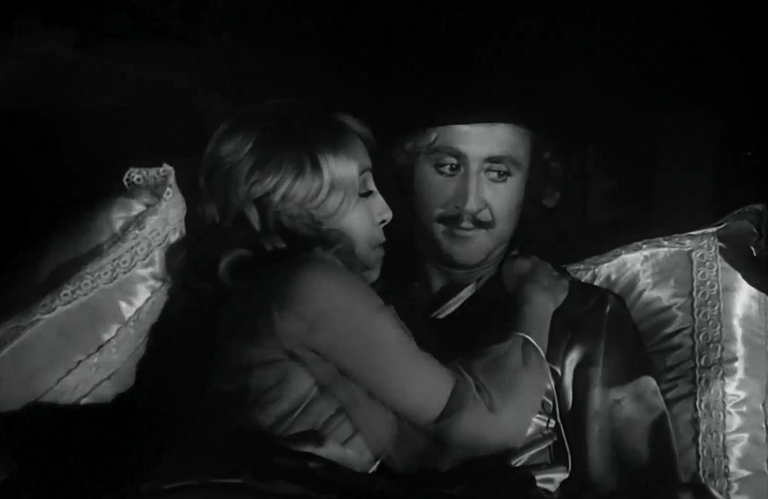

La trama inicia en una clase universitaria del profesor neurólogo Frankestin (que ha decidido cambiar levemente su apellido para diferenciarse de su abuelo, el celebrado científico Víctor von Frankenstein, autor de diversas teorías médicas consideradas por su nieto como absurdas y producto de una mente desequilibrada)
La primera sonrisa en el espectador se produce cuando el profesor reacciona airado ante la pregunta de uno de sus alumnos que, primero, lo llama con el apellido de su abuelo para provocarlo y luego le pregunta si es posible revivir a una persona muerte trasplantándole órganos de otra persona fallecida debidamente conservados. En su reacción violenta, el profesor (un genial Gene Wilder) golpea repetidamente el escritorio con el puño sin advertir que dentro del mismo aprieta un punzón de hierro usado en sus explicaciones prácticas. Al tercer golpe erra el escritorio y se clava el punzón en la pierna. Rengueando y con una mueca, deja el aula ante la hilaridad de sus alumnos.
Al dejar la universidad recibe la visita de un abogado quien, en representación de su abuelo, le comunica que este ha fallecido y le ha dejado en herencia un castillo en Transilvania, Rumania.
Si bien, en principio, es proclive a rechazar la herencia por el profundo desprecio que siente por los experimentos de su abuelo, la curiosidad es más fuerte y decide viajar a Transilvania para ver que se trata.
Cuando llega al castillo es recibido por el criado Aigor (jorobado, pero con la particularidad que puede cambiar la posición de la joroba a su placer) quien en realidad se presenta como Igor dándole el bienvenido llamándolo profesor Frankenstein. Al sentir de nuevo un apellido que detesta, el profesor le dice que su apellido no es ese, sino Frankestin (y remarca las sílabas para que lo entienda). El criado no toma muy bien la respuesta y le responde que, en el futuro, él también se llamará no Igor sino Aygor. Toda esta secuencia de gags y comicidad tan del estilo de Mel Brooks se repetirá durante toda la película.
Igor (o Aygor)toma las maletas del recién llegado y para hacerle un despecho se gira hacia los caballos de la carroza y pronuncia secamente el nombre: Blucher!, que es el apellido de la gobernante de la mansión, sabiendo que los animales reacciones asustados y en este caso relinchando al sentirlo. Satisfecho y sonriendo, entra en el castillo con el profesor Frankestin.
Una vez instalado, el profesor se dedica a revisar los viejos manuscritos de su abuelo referidos a sus experimentos para revivir a personas muertas con órganos de otras personas y aplicaciones de electroshocks y se da cuenta de que son tan disparatados. En definitiva, su abuelo tan loco no estaba, al contrario, era un científico con una visión de futuro. Y a medida que avanza en la lectura de todo el material que el anciano barón había dejado, más se convence de que el proyecto puede ser realizado.
De esta manera, con la ayuda de Igor, la asistente Inga y Frau Blucher van a un cementerio de noche y roban un cadáver apenas sepultado. Para dotarlo de vida necesitan robar un cerebro y de tal tarea se debe encargar Igor, que debe entrar clandestinamente en un laboratorio donde hay varios cerebros en formol destinados a las experimentaciones.
Cuando recoge el cerebro correcto (de acuerdo a las instrucciones del profesor) se gira para alejarse, pero tropieza y cae rompiendo el frasco e inutilizando su precioso contenido. En la desesperación recoge de los estantes el primer frasco que encuentra al alcance de la mano sin darse cuenta de que en la etiqueta que identifica a cada cerebro está escrito "abnormal", es decir, es el cerebro de una persona con trastornos mentales.
El espectador ya comienza a imaginar la serie hilarante de gags y risas que se suceden a continuación.
En la azotea del castillo, el profesor coloca el cadáver con el cerebro trasplantado (ignora el accidente de Igor) coloca alrededor de la cabeza una serie de electrodos que conecta a un pararrayos (siguiendo el esquema del invento de Benjamin Franklin) en una noche de tempestad.
El impulso eléctrico del rayo logra dar vida a la criatura y él experimenta, se revela un suceso. Pero mientras todos festejan en medio de la algarabía, el monstruo se despierta y pretende estrangular al profesor. Un calmante propinado con una inyección logra calmarlo, pero el profesor no entiende el motivo de la reacción y por este motivo comienza a sonsacarle a Igor la verdad. Cuando este le cuenta toda la historia, pretende estrangularlo a su vez al ayudante en un gesto de rabia, pero los ayudantes logran separarlos.
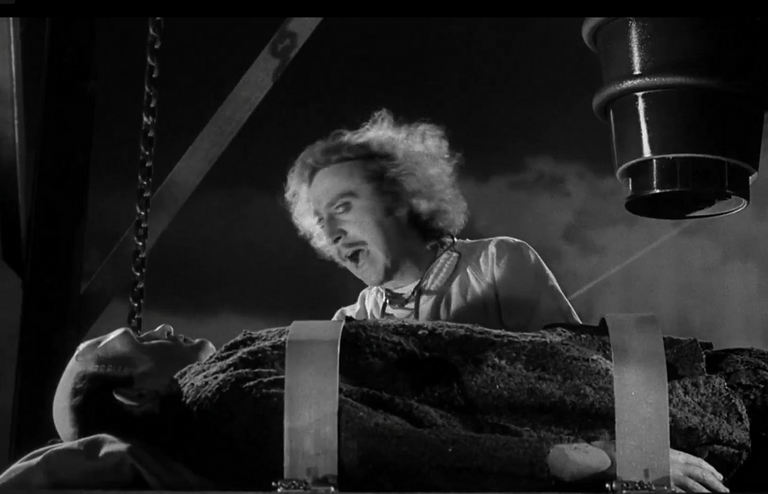
Cuando el monstruo se despierta de a poco, el profesor Frankestin comienza a explicar la situación, le dice que él también es un ser humano especial, con todas las virtudes y defectos que tienen los demás. Se muestra comprensiva y logra convencerlo a una reunión científica en un teatro donde han sido invitados distinguidos colegas de la profesión, en general muy escépticos.
Todo va siguiendo un curso normal, en una velada más que amena, hasta que un principio de incendio en el teatro asusta al monstruo que huye. En su itinerario de huida se encuentra con una niña que se ha alejado de su casa sin avisar a sus padres y está jugando de noche en el jardín en una hamaca. Intenta darle un empujón para ayudarse a balancearse, pero es tan fuerte que la niña sale volando y aterriza en su propia cama ante la dicha de sus padres que acaban de abrir la puerta de la habitacion.
Sigue su camino y se encuentra con un mendigo ciego (a quien en realidad el monstruo toma por sordo) con quien comparte primero un plato de sopa (al tratar de servirlo en el plato con el cucharón se la echa encima de los pantalones al pobre ciego -participación breve, pero desopilante de Gene Hackman-), luego comparte una taza de café y cuando trata de brindar por los dos impacta ambas tazas con tal fuerza que las rompe y para terminar le ofrece un habano y en vez de encender el cigarro le da fuego al dedo enguantado del pobre mendigo.
Todas las escenas son hilarantes, desopilantes, de una comicidad tan genuina y tan gestual que uno nunca se cansa de verlas (yo vi la película tres veces).
Al final es capturado por la policía, encerrado y sujeto a torturas psicológicas por uno de los guardianes, quien lo asusta con el fuego. En un determinado momento, muy asustado, lo golpea al policía y huye de nuevo de la prisión.
A este punto sabe que el único lugar seguro es el castillo porque sabe que el profesor Frankestin lo protegerá.
En efecto, cuando llega en recibido por todo el grupo y luego de un breve conciliábulo, el profesor Frankenstin decide generosamente que el único modo de salvarlo es donarle su cerebro, de esta manera aprenderá a hablar y ninguno lo podrá acusar de ser un monstruo, será un humano más.
A este punto, el mismo Igor, Inga, su novia que lo había acompañado desde los EE. UU. tratan de disuadirlo, pero el profesor sostiene que si quieren salvarlo es la única alternativa posible.
Preparan de nuevo el experimento y en el momento culminante del mismo la policía interrumpe en el castillo. Ambos se alzan de las camillas y el inspector de policía Kemp descubre que ambos son humanos, aunque uno tenga una cicatriz que rodea toda su cabeza.
El mayor interrogativo es saber si en el experimento todo ha ido bien: en efecto, la última secuencia muestra a un monstruo vestido con la bata en compañía de la asistente Inga mientras lee un diario de noticias financieras.
¿Pero el monstruo que le ha transferido al profesor?
Volvemos un poco hacia atrás. En su primera huida, el monstruo para vengarse había ido hasta la casa del profesor y había violentado a su novia (aunque la palabra violentar es tal vez excesiva porque aparentemente Elizabeth -la novia del profesor- había quedado muy satisfecha de la prueba de las dimensiones del aparato reproductor del monstruo). Y expresa su júbilo y placer cantando un aire de soprano.
Pues bien, en la escena final el profesor apaga la luz dando a entender que tienen intenciones de hacer el amor con su mismo y luego de unos instantes se siente el mismo aire, satisfecha, de placer, de soprano.
El espectador en medio de la hilaridad descubre que es lo que el monstruo le ha transferido al profesor. Aun en medio de un concepto de cierta vulgaridad, Mel Brooks logra arrancar al espectador una amplia sonrisa que no tiene nada de vulgar.
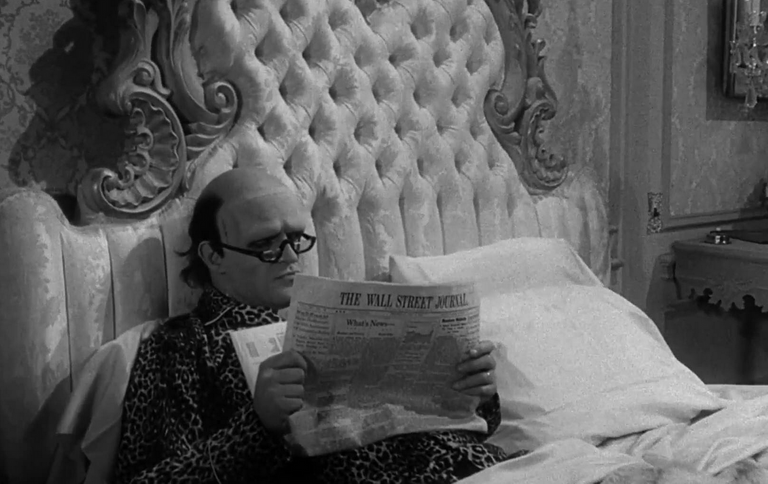

Gene Wilder as/como: Dr. Frederick von Frankenstein.
Marty Feldman as/como: Igor.
Cloris Leachman as/como: Frau Blücher.
Kenneth Mars as/como Hans Wilhelm Friederich Kemp
Gene Hackman as/como: Blind beggar / Mendigo ciego.
Madeline Kahn as/como: Elizabeth.
Peter Boyle as/como: The Monster / La Criatura.
Teri Garr as/como: Inga
Source/Fuente: IMDB.

Shot in black and white with a meticulousness that borders on the obsessive, Mel Books manages to make a masterpiece of comedy in a film based on a horror classic.
The popular comic actor and director wanted to be so detailed in the elements used that he even used the test tubes and other elements that had been used in James Whale's Frankenstein of 1931, that is, forty years earlier.
One of the set designers of the film had kept in his house in San Monica all the laboratory, manuscripts, test tubes and books used in that 1931 version and after an agreement with Mel Brooks he gave them to him for Young Frankenstein.
The teaching that the film directed by Mel Brooks leaves us is that no film director should be afraid of any myth of any film genre, since none can escape the reach of fine humor and quality when there is a good scenery and excellent actors to support it.
In this way (and in his own way) Mel Brooks succeeds in stripping certain dimensions of cinematic spectacle of its untouchable aura, transforming it and returning it to its natural condition of cultural entertainment.
Absolutely recommended.

Filmada en blanco y negro con una meticulosidad que raya en lo obsesivo, Mel Books logra hacer una obra maestra de la comicidad en una película basada en un clásico del horror.
El popular actor y director cómico quiso ser tan detallista en los elementos usados que incluso uso las probetas y demás elementos que habían sido usados en el Frankenstein de James Whale de 1931, es decir, cuarenta años antes.
Uno de los escenógrafos de la película había conservado en su casa de San Mónica todo el laboratorio, los manuscritos, las probetas y los libros utilizados en aquella versión de 1931 y luego de un acuerdo con Mel Brooks se los cedió para el Joven Frankenstein.
La enseñanza que nos deja la película dirigida por Mel Brooks es que ningún director de cine debe tener miedo a ningún mito de cualquier género cinematográfico, ya que ninguno puede escapar al alcance del humorismo fino y calidad cuando hay una buena escenografía y excelentes actores que lo sustenten.
De esta manera (y a su manera) Mel Brooks logra despojar de esa aura de intocable a ciertas dimensiones del espectáculo cinematográfico, transformándolo y devolviéndolo a su natural condición de entretenimiento cultural.
Absolutamente recomendada.

In 1975, it was nominated for an Academy Award for Best Non-Original Screenplay for Mel Brooks and Gene Wilder and Best Original Score for Richard Portman and Gene S. Cantamessa. Cantamessa
Also that same year, Cloris Leachman was nominated for a Golden Globe for Best Actress in a Motion Picture Comedy or Musical and Madeline Kahn for Best Supporting Actress.
A year later, in 1976, after the success of public and critics, it won the Saturn Award (awarded annually by members of the Academy of Science Fiction, Fantasy & Horror Films to the best works in science fiction, fantasy and horror, relative to film)for Best Horror Film, Best Director (Mel Brooks), Best Supporting Actor (Marty Feldman) and Best Set Design (Robert De Vestel and Dale Hennesy).

En el año 1975 fue nominado al Óscar de la Academia de Hollywood como mejor guion no original para Mel Brooks y Gene Wilder y como mejor banda sonora para Richard Portman y Gene S. Cantamessa
También en ese mismo año fue nominada al Globo de Oro, Cloris Leachman a la mejor actriz en una película de comedia o musical y Madeline Kahn como a la mejor actriz de reparto
Un año más tarde, en 1976, luego del suceso de público y crítica, obtuvo el Premio Saturn (otorgado anualmente por los miembros de la Academy of Science Fiction, Fantasy & Horror Films a las mejores obras de ciencia ficción, fantasía y terror en cine) a la mejor película de terror, al mejor Director (Mel Brooks), al mejor actor de reparto (Marty Feldman) y a la mejor escenografía (Robert De Vestel y Dale Hennesy).
| Crédits / Créditos by/de Wikipedia & IMDB. | by @greengalletti |
|---|---|
| Directed by / Dirigida por | Mel Brooks |
| Year /Año | 1974 |
| Based in / Basada en | Frankenstein by/de Mary Shelley |
| Original title / Título original | Young Frankenstein |

The paragraph separator -adapted- is the property of The Peak Studio to whom I am grateful for the kind permission to use it.
El separador de párrafos -adaptado- es propiedad de The Peak Studio a quien agradezco la gentil concesión de uso.
https://twitter.com/HugoRep/status/1533457679686975488
The rewards earned on this comment will go directly to the people(@greengalletti) sharing the post on Twitter as long as they are registered with @poshtoken. Sign up at https://hiveposh.com.
Thanks for the support and tokens @poshtoken.
I'm pretty sure I saw this when I was a child, but I clearly need to revisit it... with a more seasoned respect for Wilder and great filmmaking in general. Thank you for this detailed and thoughtful review!
Posted using CineTV
Gene Wilder is one of the best comedic actors I've ever seen on film and Young Frankenstein is his crowning achievement.
Greetings and thanks for commenting @thatcryptodave.
La verdad es que esta historia siempre me ha parecido interesante y también espeluznante, aunque nunca me han gustado que se combinen el suspenso u horror con la comicidad. Pienso que se pierde un poco la esencia de lo que se desea transmitir.
Son puntos de vista @hylene74
A mí personalmente las historias de horror nunca me han gustado demasiado en el cine, en la literatura en cambio creo que es distinto, la trasmisión de la idea es distinta porque tiene mucho que ver con nuestra imaginación, algo que el cine generalmente descuida, porque es básicamente, un producto visual.
En el cine me gusta más el suspenso si está bien hecho.
Respecto a mezclar temas, la parodia y la sátira se basan en ello, caso contrario no existirían.
Saludos y gracias por comentar.
Your content has been voted as a part of Encouragement program. Keep up the good work!
Use Ecency daily to boost your growth on platform!
Support Ecency
Vote for new Proposal
Delegate HP and earn more
Thank you for your support @ecency.